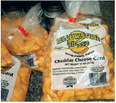Curd is the word


Served warm, cold or hot from the fryer these cheese bites are a crowd pleaser
Cheese curds. How should they be served? Cold or room temperature?...


Served warm, cold or hot from the fryer these cheese bites are a crowd pleaser
Cheese curds. How should they be served? Cold or room temperature?...